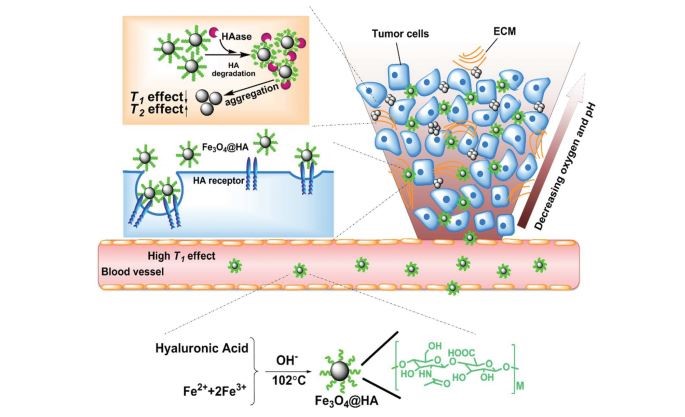超小型超顺磁Fe3O4纳米粒子在肿瘤微环境中聚集引发T1和T2显影的转换

|
无机纳米粒子表面的配体和配体密度可能会对其光学、电学、稳定性以及磁共振成像(MRI)特征有显著的影响。在这项研究中,透明质酸作为表面配体修饰超小型四氧化三铁纳米粒子(Fe3O4@HA),这一复合材料作用于肿瘤细胞,在肿瘤微环境中通过透明质酸酶(HAase)和较低pH降解HA,Fe3O4在体内聚集调整T1和T2加权磁共振成像。 为了实现这个目的,国家纳米科学中心的陈春英教授团队通过一种简单的共沉淀法,合成并表征了四种不同Fe3O4@HA纳米粒子,其HA密度是逐渐增加的。Fe3O4@HA280因具有较高r1值被选择作为体外信号调节试验; 在HAase 和酸性环境下,T2号增强了36%,T1信号减少了22%。然而在相同的测试条件下,壳聚糖涂覆的Fe3O4纳米颗粒没有显示类似的趋势。 MDA-MB-231细胞和鼠瘤信号变化图中的重叠部分也验证了Fe3O4@HA280的自组装能力。同时,肿瘤映射图显示了Fe3O4@HA280具有优异的肿瘤渗透性,这有利于纳米粒子自组装过程和增强肿瘤内部对比度。在肿瘤微环境中调换磁性这一基本技术可能为其他无机纳米粒子在肿瘤诊断和治疗领域的合理合成提供一种有用的策略。 Surface ligands and their densities may significantly influence the optic, electric, and stable properties of inorganic nanoparticles as well as their magnetic resonance imaging (MRI) characters. In this study, ultrasmall iron oxide nanoparticles with hyaluronic acid as surface ligand (Fe3O4@HA) were designed to target tumor cells and tune the T1- and T2-weighted MRI by aggregating in the tumor microenvironment via the degradation of HA upon exposure to hyaluronidase (HAase) with decreasing pH. To realize this purpose, Chunying Chen working in the CAS Key Laboratory for Biomedical Effects of Nanomaterials and Nanosafety synthesized and characterized four kinds of Fe3O4@HA nanoparticles with increasing HA density via a simple co-precipitation method . Fe3O4@HA280, with higher r1 value than others, was chosen for the signal modulation test in vitro; the T2 signal was enhanced by 36%, and the T1 signal decreased by 22% in the presence of HAase and acidic environment during the measurement. However, the chitosan-coated Fe3O4 nanoparticles did not show a similar tendency. The overlapping sections in the signal change graph of MDA-MB-231 cells and tumorbearing mice also validate the self-assembling ability of Fe3O4@HA280. Meanwhile, the tumor mapping graphs indicate the excellent tumor penetration of Fe3O4@HA280, which facilitates this self-assembly process and enhances the interior section contrast of the tumor. This fundamental technique for tuning magnetic properties by the tumor microenvironment may provide a useful strategy for the rational synthesis of other inorganic nanoparticles in the field of tumor diagnostics and therapy. (郝莉莉)
|